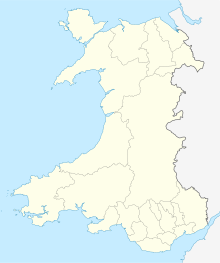Kiln from Collfryn
Coordinates: 52 ° 44 ′ 53.8 " N , 3 ° 9 ′ 17.9" W.
The Collfryn kiln ( English Collfryn corn-drying kiln ) was found in 1982 during the excavation of the enclosure Llansantffraid Deuddwr, on Collfryn Hill in Montgomeryshire in Powys in Wales .
The kiln dates back to the 15th century and was used to dry grain (wheat, oats). Since grain can only be safely stored from 14.5% moisture, depending on the weather, however, it is threshed with a higher moisture level, the moisture must be removed by drying . If the storage were too moist, fungal attack would be the result.
The system shows the typical keyhole shape that z. B. is also occupied in Haynestown in County Louth in Ireland . The Schürloch, at the end of the key beard, lies in the ditch of a much older enclosure used in the Iron Age and the Roman Empire . The base area of the round drying room, which was made up of rings of vertical plates and exposed to warm air, was cut into the wall of the enclosure. The beehive-like top made of organic material (e.g. wickerwork) has not been preserved.
Although grain skewers (Welsh: odyn grasu ) have sometimes been found in homesteads or settlements such as New Radnor, the Collfryn field skewer is unique in Wales, where this type of skewer must have been common until the early 19th century, as indicated by old field names such as Cae'r Odyn (field stove) is displayed. Traditions indicate that the grain was dried on an intermediate floor made of boards and straw or in fabric bags that were hung in the drying room. Nineteenth-century records indicate that the old-fashioned dried grain made sweeter bread than that from modern brick kilns.

